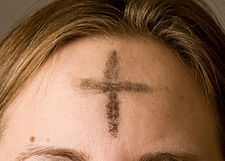On February 22 of 2012, chances are you saw few people with black smudges on their foreheads. You didn’t have to check the calendar to know it was Ash Wednesday.
In recent times, this Christian holiday has been eclipsed in many quarters by the day that precedes it, Shrove Tuesday — better known as Mardi Gras (French for Fat Tuesday).
The date for Ash Wednesday varies each year, depending on the day on which Easter Sunday falls. It can occur as early as February 4 or as late as March 10, but it is always 40 days before Easter, not counting Sundays.
The council of Nicaea in 325 decreed that Easter falls on the first Sunday immediately following the paschal moon – the first full moon on or after the vernal equinox. Ash Wednesday in the calendar of Western Christianity is the first day of Lent, a time of prayer, fasting, and repentance in preparation to commemorate the Resurrection of Christ.
Christians including Catholics, Episcopalians, Presbyterians, Methodists, Lutherans, and some Baptists may go to a Catholic church to receive ashes. The ashes are a sacramental and not a sacrament in the Catholic Church so they can be given to anyone who wishes to receive them.
Ashes used to mark a cross on the foreheads of the faithful typically are from burned palms from the previous year’s Palm Sunday. Water or olive oil may be mixed with the ashes to help them adhere to the forehead. The priest may say, “Remember thou art dust and to dust thou shall return” or “Turn away from sin and be faithful to the Gospel.”
Some believe the custom originated in the 6th century during the papacy of Gregory the Great. The tradition was formalized at the Council of Benevento in 1091.
Ash Wednesday is so popular many Catholics go to church even though it is not a Holy Day of Obligation when Catholics are required to attend. Secular calendars and appointment books frequently note Ash Wednesday along with Christmas Day and other popular holidays.
On Ash Wednesday Catholics read St. Matthew’s gospel where Jesus tells his disciples to pray, give alms, and fast privately and not publicly for all to see. Jesus said, “When you fast, do not look gloomy like the hypocrites. They neglect their appearance, so that they may appear to others to be fasting. Amen, I say to you, they have received their reward. But when you fast, anoint your head and wash your face, so that you may not appear to be fasting, except to your Father who is hidden. And your Father who sees what is hidden will reward you.” Mt 6:16-18
The Catholic Church requires fasting and abstinence from eating meat on Ash Wednesday. Catholics over 18 and under age 60 are to fast by eating only one complete meal and two smaller meals. Fasting during Lent is a reminder for man to turn away from desires of the flesh and contemplate higher things.
Fasting also can serve as penance for sin. The origin of ashes as a form of penitence is found in the Old Testament Scripture as when the prophet Daniel said, “I turned my face to the Lord God begging for time to pray and to plead, with fasting, sackcloth and ashes.” And in the book of Jonah the king in Nineveh “put on sackcloth and sat down in ashes.”


